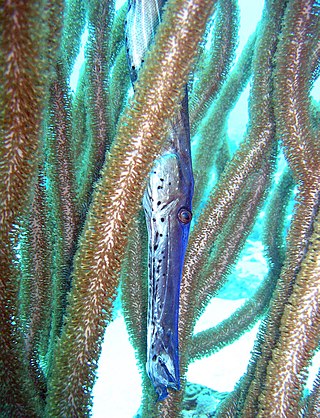
Aulostomus maculatus, the West Atlantic trumpetfish, is a long-bodied fish with an upturned mouth. It often swims vertically while trying to blend with vertical coral, such as sea rods, sea pens, and pipe sponges.

Holocentridae is a family of ray-finned fish, the only family of the order Holocentriformes. The members of the subfamily Holocentrinae are typically known as squirrelfish, while the members of Myripristinae typically are known as soldierfish. In Hawaii, they are known by the Japanese name mempachi/menpachi (メンパチ) or the Hawaiian ʻūʻū.

Sargocentron is a genus of squirrelfish found in tropical parts of the Indian, Pacific and Atlantic Oceans, with the greatest species diversity near reefs in the Indo-Pacific. Being largely or entirely nocturnal, they have relatively large eyes. Red and silvery colours dominate. The preopercle spines are venomous and can give painful wounds. Most have a maximum length of 15–25 cm (6–10 in), but S. iota barely reaches 8 cm (3 in), and S. spiniferum can reach more than 50 cm (20 in).

The longspine squirrelfish is a silvery red, sea fish with orange-gold body stripes. One of about 150 species of squirrelfish, their most distinguishing characteristics are their large eyes and the long third spine of the anal fin. It is often included in public aquarium displays. The length of the longspine squirrelfish is about 18 cm. It lives in coral reefs in tropical and warm temperate seas and eats zoobenthos. It is territorial and uses sounds called "grunts" and "staccatos" to defend its crevice, warn of danger and, in groups, intimidate predators such as the moray eel. The longspine squirrelfish is edible and harvested on a small scale.

Neoniphon is a genus of squirrelfishes.

Holocentrinae is a subfamily of Holocentridae containing 40 recognized species and one proposed species. Its members are typically known as squirrelfish and all are nocturnal. All three genera in the subfamily are found in the Atlantic and Holocentrus is restricted to this ocean. Most species in genera Neoniphon and Sargocentron are from the Indo-Pacific region and several of these occur in the Indian Ocean west of the southern tip of India.

Holocentrus adscensionis is a squirrelfish of the family Holocentridae found in the Atlantic Ocean. Its range extends from North Carolina, USA to Brazil and throughout the Caribbean Sea in the Western Atlantic and from Gabon to Ascension Island in the Eastern Atlantic. A single records were reported in 2016 from the central Mediterranean Sea off Malta and in 2023 from the Mediterranean Sea near Northern Cyprus.

The whitespotted grouper, also known as the rankin cod, ocellated rockcod, small-spotted cod, white-spotted reef-cod or whitespotted rockcod, is a species of marine ray-finned fish, a grouper from the subfamily Epinephelinae which is part of the family Serranidae, which also includes the anthias and sea basses. It has an Indo-Pacific distribution. It is closely related to two other species of white spotted groupers in the genus Epinephelus.

Neoniphon sammara, the sammara squirrelfish, also known as the blood-spot squirrelfish, slender squirrelfish, spotfin squirrelfish, armed squirrel-fish or javelin squirrelfish, is a species squirrelfish found in the Indian Ocean and Pacific Ocean from East Africa to the Hawaiian Islands. It feeds on shrimps and small crabs and fish at night and can grow up to 32.0 centimetres (12.6 in) TL in length, though its common length is only 23.0 centimetres (9.1 in) TL. Like N. opercularis, it has a venomous spine on its preopercle.
Loren Paul Woods (1913–1979) was an American ichthyologist and museum curator at the Field Museum of Natural History In Chicago. He joined the museum's education department as a guide lecturer in 1938. In 1941, he was transferred to the Division of Fishes, from where he retired in 1978. His career was interrupted by a four-year period of duty with the United States Navy during World War II. While he was in the navy, Marion Griswold Grey served as the unpaid curator, becoming an associate at the museum when Woods resumed his post. During his time at the Field Museum, he assembled specimen collections of North American freshwater fish and Atlantic, Indian, and Pacific Ocean marine fish. This material resulted in a major expansion of the museum's fishes holdings, which had previously been a mostly freshwater collection. Woods is best remembered for his publications on damselfish, squirrelfish, and Berycidae.
Neoniphon pencei, or Pence's squirrelfish, is a species of squirrelfish found in the Pacific Ocean in Rarotonga, Cook Islands and Mo'orea, French Polynesia. It differs from other species of the genus Neoniphon in number of lateral line scales, scales above and below lateral line, elements of life colour, and in COI and cytochrome b DNA sequences.
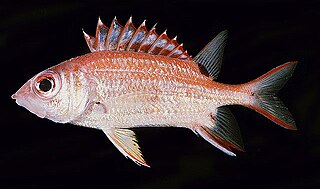
Sargocentron melanospilos, the blackbotch squirrelfish, is a species of squirrelfish in the genus of Sargocentron. It is found in the Indo-Pacific region in the Red Sea; Zanzibar, Tanzania; from Aldabra and Seychelles to the Marshall Islands and American Samoa; north to Taiwan, southern Japan and the Ogasawara Islands, and south to the southern Great Barrier Reef and the Chesterfield Islands. It is a relatively uncommon inhabitant of rocky reefs and coral-rich areas, and is usually seen solitary, but it also forms schools when in deeper water or oceanic areas.
Sargocentron inaequalis, the lattice squirrelfish, also known as the roundfinned squirrelfish, is a species of squirrelfish in the genus of Sargocentron. It is found in the Indian Ocean in the Chagos Archipelago, Comoro Islands, Seychelles and Réunion, and in the Pacific Ocean in the Line Islands in Kiribati. It is an uncommon inhabitant of rocky coral reefs.
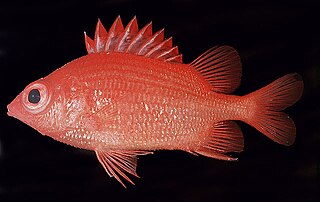
Sargocentron iota, the dwarf squirrelfish, is a nocturnal benthopelagic species of squirrelfish belonging to the genus of Sargocentron. It can be found in the Indo-Pacific region. It inhabits steep outer reef slopes.
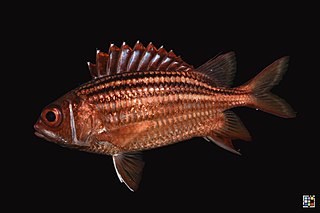
Sargocentron ittodai, the samurai squirrelfish, is a nocturnal species of squirrelfish belonging to the genus of Sargocentron. It is found in the Indo-Pacific region, in the Red Sea and Natal, from South Africa to the Marquesan Islands, and north from Southern Japan and the Ogasawara Islands, south to New South Wales, Australia. It inhabits outer reef slopes. It can be found either solitary or in groups. It mainly feeds on benthic crabs and shrimps.
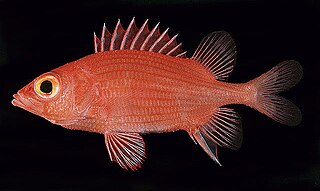
Sargocentron lepros, the spiny squirrelfish, is a nocturnal species of squirrelfish belonging to the genus of Sargocentron. It inhabits the outer reef slopes of oceanic islands, mostly in the Southern Pacific Ocean. It is normally found solitary.
Sargocentron poco, the saddle squirrelfish, is a species of squirrelfish belonging to the genus of Sargocentron. It is found in the Western Central Atlantic Ocean from the United States to the Cayman Islands, and in the Bahamas. It may also possibly be found in Cuba. It is likely to be more commonly found inhabiting shelf-edge reefs.
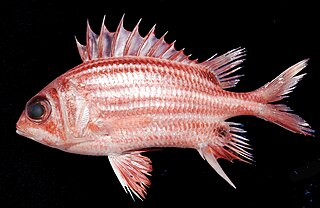
Sargocentron praslin, the dark-striped squirrelfish, is a species of squirrelfish belonging to the genus Sargocentron. It can be found in the Indian Ocean and the West Pacific Ocean, from East Africa south to Mozambique and east to the Marshall Islands excluding the northern Marshall Islands and the Society Islands. It has also been introduced into Libya, Turkey and Cyprus and may also possibly be found in Egypt and Greece. It inhabits reef flats and shallow protected reefs, often in dead reef areas. It is secretive during the day.

Sargocentron Seychellense, the yellow-tipped squirrelfish, is a species of squirrelfish belonging to the genus Sargocentron. It is found in the Western Indian Ocean in Oman, the St. Brandon Shoals, Yemen in the Socotra Archipelago, Mauritius, Réunion, Comoros, Madagascar, the Chagos Archipelago and Seychelles, which it is named after. It inhabits shallow waters of coral reefs and rocky shores, and is often found between branching corals.
Sargocentron wilhelmi, or Wilhelm's squirrelfish, is a species of squirrelfish belonging to the genus Sargocentron. It is named after ichthyologist Friedrich Wilhelm. It is endemic to Easter Island in the Southeast Pacific Ocean.















